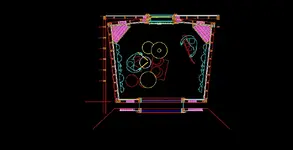I
I-AM
New member
Good Day Homerecording gurus,
I know it has been a while since I have posted, but that is because there is so much information on this site, all I do is read and am usually able to find all my answers.
Which brings me to my question of the day. I have decided to build a vocal booth due to the way my old Central Florida condo has been made. Ya know, hard marble floors and walls that just echo, and echo, and echo, and echo, and....... Well I guess you get the point.
I am using this site http://www.digitalsynthologie.de/gesangskabine/index.html
as a reference for my booth, but I have scaled it down to 3.5'x4'x7'. On this site they say that they cemented the outside panels with Rockwoll Planarock for acoustic insulation. Since I don't speak fluent German, what the heck is this stuff and where can I find simular panels for my project. I am definately sure that it is used for added accoustic isolation and the blankets on top of that sounds-well I will give it a shot since this setup is only running me about 300-500 dollars.
Also with my dimensions, I am sure there will be some bass buildup, so I was also thinking of putting fiberglass enclosed in curtains or blankets underneath the booth like it states on the site, and some bass traps directly in either the front or rear corners of the booth.
If anyone knows what type of material board or panels is equal to rockwoll or where I could purchase a simular item it would greatly appreciated.
Thank You
I know it has been a while since I have posted, but that is because there is so much information on this site, all I do is read and am usually able to find all my answers.
Which brings me to my question of the day. I have decided to build a vocal booth due to the way my old Central Florida condo has been made. Ya know, hard marble floors and walls that just echo, and echo, and echo, and echo, and....... Well I guess you get the point.
I am using this site http://www.digitalsynthologie.de/gesangskabine/index.html
as a reference for my booth, but I have scaled it down to 3.5'x4'x7'. On this site they say that they cemented the outside panels with Rockwoll Planarock for acoustic insulation. Since I don't speak fluent German, what the heck is this stuff and where can I find simular panels for my project. I am definately sure that it is used for added accoustic isolation and the blankets on top of that sounds-well I will give it a shot since this setup is only running me about 300-500 dollars.
Also with my dimensions, I am sure there will be some bass buildup, so I was also thinking of putting fiberglass enclosed in curtains or blankets underneath the booth like it states on the site, and some bass traps directly in either the front or rear corners of the booth.
If anyone knows what type of material board or panels is equal to rockwoll or where I could purchase a simular item it would greatly appreciated.
Thank You

 What this says is you will hear sound transmission IN THE ROOM that the vocal booth resides, and one room away you will hear "nothing", and outside of the studio you will hear "less nothing". Hahahahahaha! Ok, enough poking fun. The reality is..
What this says is you will hear sound transmission IN THE ROOM that the vocal booth resides, and one room away you will hear "nothing", and outside of the studio you will hear "less nothing". Hahahahahaha! Ok, enough poking fun. The reality is.. In essence, this means about a half of the abosoption in Sabines at 1khz has been also removed. Although the surface area has been increased via the shape, the reality is the performance has been REDUCED.
In essence, this means about a half of the abosoption in Sabines at 1khz has been also removed. Although the surface area has been increased via the shape, the reality is the performance has been REDUCED. 
 This is a .dwg converted to .gif so the clarity suffers during compression. When plotted, or viewed with an Autocad viewer, it is extremely clear. Your will recieve .dwg files for plotting. Of course, the plans will be detailed and dimensioned. This is for illustration only.
This is a .dwg converted to .gif so the clarity suffers during compression. When plotted, or viewed with an Autocad viewer, it is extremely clear. Your will recieve .dwg files for plotting. Of course, the plans will be detailed and dimensioned. This is for illustration only.